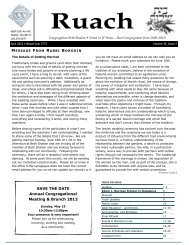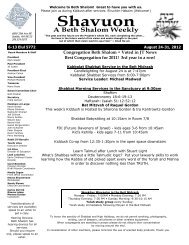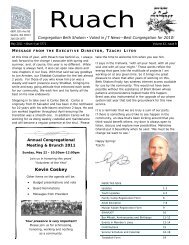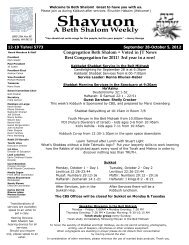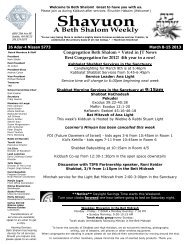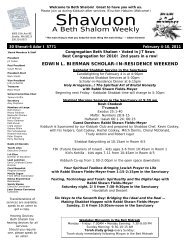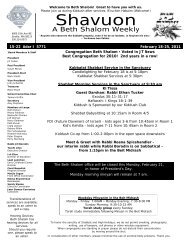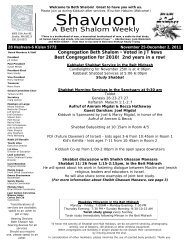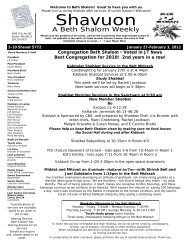Gabbai Manual - Congregation Beth Shalom
Gabbai Manual - Congregation Beth Shalom
Gabbai Manual - Congregation Beth Shalom
- No tags were found...
You also want an ePaper? Increase the reach of your titles
YUMPU automatically turns print PDFs into web optimized ePapers that Google loves.
them. Please place them on one of the desks in the office, open to the damaged or written on page sothe staff can take care of the problem.GreetingAn important part of the gabbi’im job is to help make congregants and guests feel welcomed andcomfortable in our synagogue. Everyone should be greeted with a smile and a friendly “hello” or“Shabbat <strong>Shalom</strong>”. This is especially true for visitors or first timers. If you see someone you don’trecognize, introduce yourself, welcome them to the shul, etc. If you’re not sure if they have been at<strong>Beth</strong> <strong>Shalom</strong> before, ask “Is this your first time here?”, or “I don’t remember meeting you before”. It isalso helpful to know if the guest is a Kohen or a Levi.Recently one of our members spent the year in Israel and wrote of her synagogueexperiences there:“My observations as a newcomer at synagogues here is that shuls that have someonewho greet me at the door, say “Shabbat <strong>Shalom</strong>”, and hand me a siddur, really feelso significantly more welcoming. Basically, you shouldn’t underestimate theimportance of what you are doing. A smile, a hello; it really makes a hugedifference. I now see that even a brief greeting makes a huge difference. We’ve beenplaces where nobody has even said hello to us and if feels awful. Just a “hello”changes everything. Seems so simple. And an announcement from the bimah ofwelcome to newcomers is only meaningful if there is a personal hello by members ofthe congregation when you come in the door and when services end. It doesn’t feellike the bimah welcome is sincere without the personal touch that can only come fromthe members.”Kippot and TallisimKippot and tallism should be worn by all men in the sanctuary. Women going on the bimah shouldwear kippot, and should wear tallism for Torah reading, aliyot, gelilah, and hagbah. Women are NOTrequired to wear tallism for opening and closing the ark or for the four special readings (peace, country,government, Israel).2004, page 3
The Bar or Bat Mitzvah family is responsible for informing participants of their responsibilities forwearing kippot and tallism. Since, at times, people still come up to the bimah without them, othermonitoring must take place by the gabbi’s and the gabbi shaini.The gabbi’s should be sure there are extra kippot and tallism on the bimah before services start so theyare available if someone goes up without them on.It is the responsibility of the gabbai’s to prevent people having honors from going up on the bimahwithout their heads covered, and appropriately wearing tallism. Since you know, almost 100% of thetime, who has these honors, please check heads and shoulders when giving out the aliyahs andBEFORE they go up on the bimah. Just go through the list of honors and check heads andshoulders. If anyone gets by, the gabbai shani should be the one to notice, and provide a kippah and/ora tallis from the bimah so you don’t have to chase people once they’re on the bimah.Also, the aliyah cards have instructions on the back of them reminding people with those honors to beready early, to wear kippot and tallism, and the pages for the opening and closing the ark, the aliyahs,and the readings.AliyahsAliyahs may be requested by members of the congregation by calling the office in advance. There is aclear envelope on the outside of the gabbai box with the requests. B’nai Mitzvah families are instructedto leave at least 2 aliyahs available for the congregation – at least one of which is a Yisroel. The otherplace to note when considering who to assign the aliyahs to is the Shavuon, which lists the people thathave Yartzeit’s in the coming week.One must be beyond B’nai Mitzvah age in order to be eligible for an aliyah - even if the actualceremony has not occurred. This is age 12 for girls and 13 for boys. Non-Jews are not eligible to havealiyahs - even non-Jewish parents of a Bar/t mitzvah. Both men and women should have their headscovered and wear a tallit during the aliyah and when on the bimah.Please be sure that everyone that receives an aliyah is dressed appropriately – no jeans or inappropriateclothing (shorts, WAY too short skirts)In order to keep the service moving smoothly, especially during a Bar/t Mitzvah, when distributing thealiyahs ask the individuals to be ready during the aliyah prior to his/hers. They may sit in the front rowduring the previous aliyah. The gabbi who has distributed the aliyahs should be in the sanctuary during2004, page 4
efore the Torah service. There should be a minimum of two aliyot available for the congregation, atleast one of which is a Yisroel.Who can do what? There are lists in the gabbi box of Kohenim, and Leviim. Please let the coordinatorknow if there are names to add to or remove from the list. (Please do not write new names on the liston Shabbat.)B’Nai MitzvahThe gabbi’im role during a Bnai Mitzvah expands to assist the family in making the service very special,and to help assure that everything goes smoothly. Offer yourself to the family if they have any specificneeds. Review the list of aliyah’s with them, and ask them to help you identify the individuals asnecessary. The families may have already arranged for kids to help pass out prayerbooks. Somegabbi’im have chosen to call the families prior to Shabbat to just touch base. The families reallyappreciate any added touch in making their day successful.DecorumCongregants and their children are expected to act respectfully during services. It is the gabbai’sresponsibility to assure that the environment is one that permits congregants to pray and to enjoy thespirituality of Shabbat and of being in shul. Older children who are making noise and disrupting theservice should be asked to leave the sanctuary. With younger children, the gabbi may need to help theparents find an alternative location. Remember the children’s services and child care programs that areavailable on Shabbat.Parents frequently bring food for younger children. The effect of spilled food and drinks on thecarpeting and upholstery must be considered. No food is to be eaten in the sanctuary during theKiddush.There are frequently guests in the congregation for B’nai Mitzvah or other celebrations who are notfamiliar with Shabbat observance or other practices, such as writing, using cameras and cell phones, andplacing prayerbooks on the floor. Please note these occurrences and assist guests follow traditionalpractices in the shul.2004, page 8
Birckat haKodeshBirckat ha Kodesh is said on the Shabbat before Rosh Hodesh when Rosh Hodesh occurs during theweek. The Torah is held by the person saying the prayer. The Ruach indicates if Birckat ha Kodeshoccurs on any Shabbat. Check with the Rabbi regarding who will do the blessing.Traffic in the SanctuaryThere are several times during the service that we limit traffic in and out of the sanctuary for reasons ofrespect and consideration. During those times, one gabbai should be at the door inside the sanctuary,requesting that people do not come in and out. Those times are as follows:• When the congregation is standing during the Amidah and Kedushah of Shacharit and Musaf• During the Torah service while the Torah is actually being read• During the D’var Torah• During the charge of the Bar or Bat MitzvahOther Shabbat ActivitiesThere are usually children’s services downstairs in the education wing. Information on those serviceswill be in the weekly Shavuon which is available to congregants in the sanctuary, and also in the mostrecent Ruach which is sitting on the information shelves in the lobby.KiddushKiddush is usually made in the sanctuary immediately preceding Adon Olam. When there is a sponsoredmeal, after Kiddush, there is washing and Ha Motzi is made. When there is no sponsored meal, afterKiddush the fruit or cake will be served following the appropriate prayer. Birkat HaMazon is said onlywhen HaMotzi was made.Chaggim and Rosh ChodeshThere are special days throughout the year where services are different than on Shabbat, and the gabbineeds to know what to expect and what to provide. All of these descriptions are found in the Luach,the book that provides information about all Shabbat and holiday services. The Luach is found in thegabbi box, and should be reviewed every Shabbat and festival, prior to services, to determine whensomething special is needed. Some things to remember:2004, page 9
Torah’s - Two Torahs are used on all major festivals, high holidays, on Rosh Chodesh, and on fourother designated Shabbatot. On these days two Hagbah’s and Gelilah’s are needed, as well as anadditional person to carry the Torah when it is taken out and placed back in the Ark.Hallel - Hallel (either full or abridged) is said on all major festivals and on Rosh Chodesh, not on theHigh Holidays. During Hallel the Torahs are held throughout, usually by the people selected to takethem out and put them back in the Aron. (Take that into consideration when selecting those people)Megillot - Specific Megillot are read on designated festivals:Sukkot - Koheleth (Ecclesiastes)Purim - EstherPesach - Sher Ha Sherim (Song of Songs)Shavuot - RuthTish’ah B’Av - LamentationsThe book of Megillot can be distributed either during the service and/or made available as people enterthe sanctuary.Yiskor - Yiskor is said on Yom Kippur, the second day of Shavuot, Sh’mini Atzeret, and on the lastday of Pesach. It is said after the Torah service, prior to putting away the Torahs. Both Torahs areheld during the Yiskor service. Yiskor is immediately followed by putting away the Torahs so the samepeople holding the Torahs for Yiskor can put them away. Select people who can hold the Torahs for along period of time.2004, page 10
Regular Shabbat 1Summary of Special ServicesTorahs Hallel Megillah YiskorRosh ChodeshShabbat2 x - half“Special” Shabbatot 2 xSukkot 2 x KoheletSh’mini Atzeret 2 x Kohelet xPurim 2 EstherPesach 2 x, ½ days 2-8 Sher Ha Sherim day 8Shavuot 2 x Ruth day 2Tish’ah B’Av 2 x LamentationsRosh Hashonah 2Yom Kippur 2 xSchedulingTwo gabbi’im are usually scheduled together. A schedule is sent out around the 15th of each month tofor the subsequent month. If there are schedule requests prior to the monthly schedule going out,please let the coordinator know so s/he can consider that in doing the schedule. I will request scheduleinformation the month before, and the more info I have the fewer changes that have to be made.Schedule changes after the schedule comes out should be done among each other, but please let thecoordinator know of the changes.The schedule is listed on the <strong>Beth</strong> <strong>Shalom</strong> Web Site under Committees – <strong>Gabbai</strong> – schedule. You canput the site in your favorites an go to it at any time.http://www.bethshalomseattle.org/committees/gabbaim.php3?page=7082004, page 11
Gabbi’im are scheduled to serve approximately once a month, depending on the number of availablegabbi’im. However, on occasion, due to the numbers of Shabbatot and available gabbi’im, there may bea need to serve more than once in a month. There is an attempt to distribute this equally.The Shabbat gabbi’im are not responsible for serving on Rosh Hashonah or Yom Kippur, but they areexpected to serve on the festivals (Sukkot, Shavuot, Pesach). The months with festivals often requireone additional day in the month per gabbi. These extra days are rotated to the extent possible.Newer gabbi’im are paired up with experienced gabbi’im and work the same schedule for the first 3-4months. The experienced gabbi’im will function as mentors. After the initial few months the newerones will be added to the regular rotation.Months off are rotated to assure an equal distribution throughout the year. There is an attempt torotate pairing of gabbi’im, and to schedule several weeks between assigned dates. Anyone interested inreviewing the master schedule may feel free to ask for it.2004, page 12



